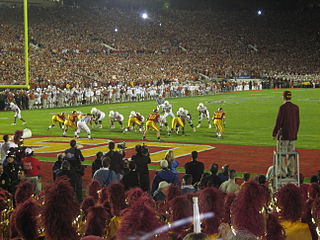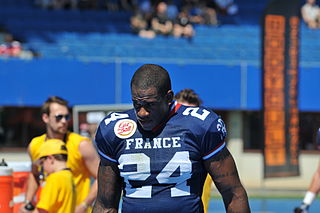
The Canadian Football League is a professional sports league in Canada. The CFL is the highest level of competition in Canadian football. The league consists of nine teams, each located in a city in Canada. They are divided into two divisions: four teams in the East Division and five teams in the West Division.

NFL Europe League was a professional American football league that functioned as the developmental minor league of the National Football League (NFL). Originally founded in 1989 as the World League of American Football, the league was envisioned as a transatlantic league encompassing teams from both North America and Europe. Initially, the WLAF consisted of seven teams in North America and three in Europe. It began play in 1991 and lasted for two seasons before suspending operations; while the league had been "wildly popular" in Europe, it failed to achieve success in North America. After a two-year hiatus, it returned as a six-team European league, with teams based in England, Germany, the Netherlands, Scotland, and Spain. NFL Europa was dissolved in 2007 due to its continued unprofitability and the NFL's decision to shift its focus towards hosting regular-season games in Europe; at the time of its closure, the league consisted of five German teams and one team based in the Netherlands.

Women's gridiron football, more commonly known as women's tackle football, women's American football, women's Canadian football, or simply women's football, is a form of gridiron football played by women. Most leagues play by similar rules to the men's game. Women primarily play on a semi-professional or amateur level in the United States. Very few high schools or colleges offer the sport solely for women and girls. However, on occasion, it is permissible for a female player to join the otherwise male team.

The National Association of Intercollegiate Athletics (NAIA) established in 1940, is a college athletics association for colleges and universities in North America. Most colleges and universities in the NAIA offer athletic scholarships to their student athletes. For the 2023-24 season, it had 241 member institutions, of which two are in British Columbia, one in the U.S. Virgin Islands, and the rest in the continental United States, with over 83,000 student-athletes participating. The NAIA, whose headquarters is in Kansas City, Missouri, sponsors 28 national championships. CBS Sports Network, formerly called CSTV, serves as the national media outlet for the NAIA. In 2014, ESPNU began carrying the NAIA Football National Championship.

In North America, a bowl game, or simply bowl, is one of a number of postseason college football games that are primarily played by teams belonging to the NCAA's Division I Football Bowl Subdivision (FBS). For most of its history, the Division I Bowl Subdivision had avoided using a playoff tournament to determine an annual national champion, which was instead traditionally determined by a vote of sports writers and other non-players. In place of such a playoff, various cities across the United States developed their own regional festivals featuring postseason college football games. Prior to 2002, bowl game statistics were not included in players' career totals. Despite attempts to establish a permanent system to determine the FBS national champion on the field, various bowl games continue to be held because of the vested economic interests entrenched in them.

The Amsterdam Admirals were a professional American football team based in Amsterdam, Netherlands, playing in the NFL Europe.

The Alamodome is a 64,000-seat domed indoor multi-purpose stadium in San Antonio, Texas. It is located on the southeastern fringe of downtown San Antonio. The facility opened on May 15, 1993, having been constructed at a cost of $186 million.

Louis Roy Groza, nicknamed "the Toe", was an American professional football offensive tackle and kicker while playing his entire career for the Cleveland Browns in the All-America Football Conference (AAFC) and National Football League (NFL). Groza was professional football's career kicking and points leader when he retired after the 1967 season. He played in 21 seasons for the Browns, helping the team to win eight league championships in that span. Groza's accuracy and strength as a kicker influenced the development of place-kicking as a specialty; he could kick field goals from beyond 50 yards (46 m) at a time when attempts from that distance were a rarity. He set numerous records for distance and number of field goals kicked during his career.
The history of American football can be traced to early versions of rugby football and association football. Both games have their origin in multiple varieties of football played in the United Kingdom in the mid-19th century, in which a football is kicked at a goal or kicked over a line, which in turn were based on the varieties of English public school football games descending from medieval ball games.
The American Bowl was a series of National Football League pre-season exhibition games that were held at sites outside the United States between 1986 and 2005.
Mick Deegan is a former manager of the Dublin junior Gaelic football team and Fingal Ravens. He is a former inter-county Gaelic footballer for Dublin, and a former footballer for Crusaders.

John Jay "Big John" Kissell was an American football defensive tackle who played for the Buffalo Bills in the All-America Football Conference (AAFC) and the Cleveland Browns in the National Football League (NFL) in the 1940s and 1950s. He played college football at Boston College.
Christopher L. Howard is a retired professional American football running back who played in the National Football League (NFL) for the Jacksonville Jaguars. Howard had been drafted by the Denver Broncos in the fifth round of the 1998 NFL Draft. His professional football career was haunted by fumble troubles, which caused the Broncos to release him before he played a regular season game for them. Howard began to have fumble problems again when the Jaguars acquired and promoted him to a role as a regular player.

American football, also known as gridiron, is a team sport played by two teams of eleven players on a rectangular field with goalposts at each end. The offense, the team with possession of the oval-shaped football, attempts to advance down the field by running with the ball or passing it, while the defense, the team without possession of the ball, aims to stop the offense's advance and to take control of the ball for themselves. The offense must advance at least ten yards in four downs or plays; if they fail, they turn over the football to the defense, but if they succeed, they are given a new set of four downs to continue the drive. Points are scored primarily by advancing the ball into the opposing team's end zone for a touchdown or kicking the ball through the opponent's goalposts for a field goal. The team with the most points at the end of a game wins.

Sébastien Sejean is a former American football safety. He played CIS football for the Université Laval Rouge et Or.

The Mexico national American football team (Spanish: Selección de fútbol americano de México) represents Mexico in international American football competitions. The team is controlled by the Mexican American Football Federation. Mexico has participated in competitions such as the Aztec Bowl, the IFAF World Championship, and the IFAF Junior World Championship.
The Austrian Football League (AFL) is the highest level of American football in Austria founded in 1982. The Austrian Football League (AFL) has always been considered among the best and strongest leagues in Europe. The league plays by rules based on those of the NCAA.

The modern history of American football can be considered to have begun after the 1932 NFL Playoff Game, which was the first American football game to feature hash marks, the legalization of the forward pass anywhere behind the line of scrimmage, and the movement of the goal posts back to the goal line; it was also the first indoor game since 1902. Other innovations to occur in the years after 1932 were the introduction of the AP Poll in 1934, the tapering of the ends of the football in 1934, the awarding of the first Heisman Trophy in 1935, the first NFL draft in 1936 and the first televised game in 1939. Another important event was the American football game at the 1932 Summer Olympics, which combined with a similar demonstration game at the 1933 World's Fair, led to the first College All-Star Game in 1934, which in turn was an important factor in the growth of professional football in the United States. American football's explosion in popularity during the second half of the 20th century can be traced to the 1958 NFL Championship Game, a contest that has been dubbed the "Greatest Game Ever Played". A rival league to the NFL, the American Football League (AFL), began play in 1960. In 1966, the NFL initiated the AFL–NFL merger between the two leagues. The merger lead to the creation of the Super Bowl, which has become the most watched television event in the United States on an annual basis.
Minor league football, also known as alternative football or secondary football, is an umbrella term for pro football (gridiron) that is played below the major league level.












